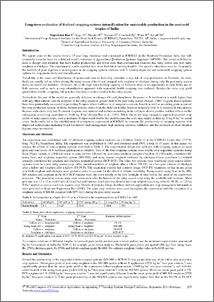Long-term evaluation of dryland cropping systems intensification for sustainable production in the semi-arid tropics of India
Abstract
We report some of the results from a 15-year long rotational trial conducted at ICRISAT in the Southern Peninsular India that will eventually form the basis for a detailed model evaluation of Agricultural Production Systems Simulator (APSIM). This model will then be used to design crop rotations that have higher productivity and lower risks than conventional rotations like rainy fallow and post rainy sorghum or chickpea. The experimental results reported here show that this is entirely feasible. Our specific objectives were to: 1) quantify the benefits of grain legumes to non-legumes in the cropping system rotations; and 2) identify improved and sustainable cropping system options for crop productivity and intensification. Variability in the onset and distribution of monsoonal rains in June-July constitute a key risk of crop production on Vertisols. As such, fields are usually left as fallow during the rainy season (kharif) and cropped with sorghum or chickpea during only the post-rainy season (rabi) on stored soil moisture. However, due to the high water holding capacity of Vertisols, there is an opportunity to make better use of both seasons, and as such, a crop intensification approach with sequential double cropping was explored. Besides the extra crop yield gained from double -cropping, this practice may help to reduce erosion in the rainy season. Vertisols in this part of the world are generally deficient in nitrogen (N) and phosphorus. Response to N fertilization is much higher than with any other nutrient, and the response in the rainy season is greater than in the post-rainy season (Katyal, 1988). Legume-based systems have been particularly successful in providing N inputs where fertilizer is of marginal economic benefit as well as providing grain as part of the crop production system. In India, farmers remove stalks from the field for fodder, however relatively little N is removed in this process because stalks have very low N content. Legume root material and nodules remaining in the soil have shown positive residual effects on the subsequent cereal crop equivalent to 30-40 kg N ha-1(Kumar Rao et al., 1983). While this is not large enough to approach potential crop yields of rainy season crops, even a moderate N input could double the yield because the soils may supply as little as 30 kg N ha-1 to cereal crops. Such results led to the establishment of a long-term experiment at ICRISAT to examine the productivity of cropping systems with improved technologies including broad bed furrow land management, high yielding varieties, fertilizers and the inclusion of short duration legume crops in rotations

